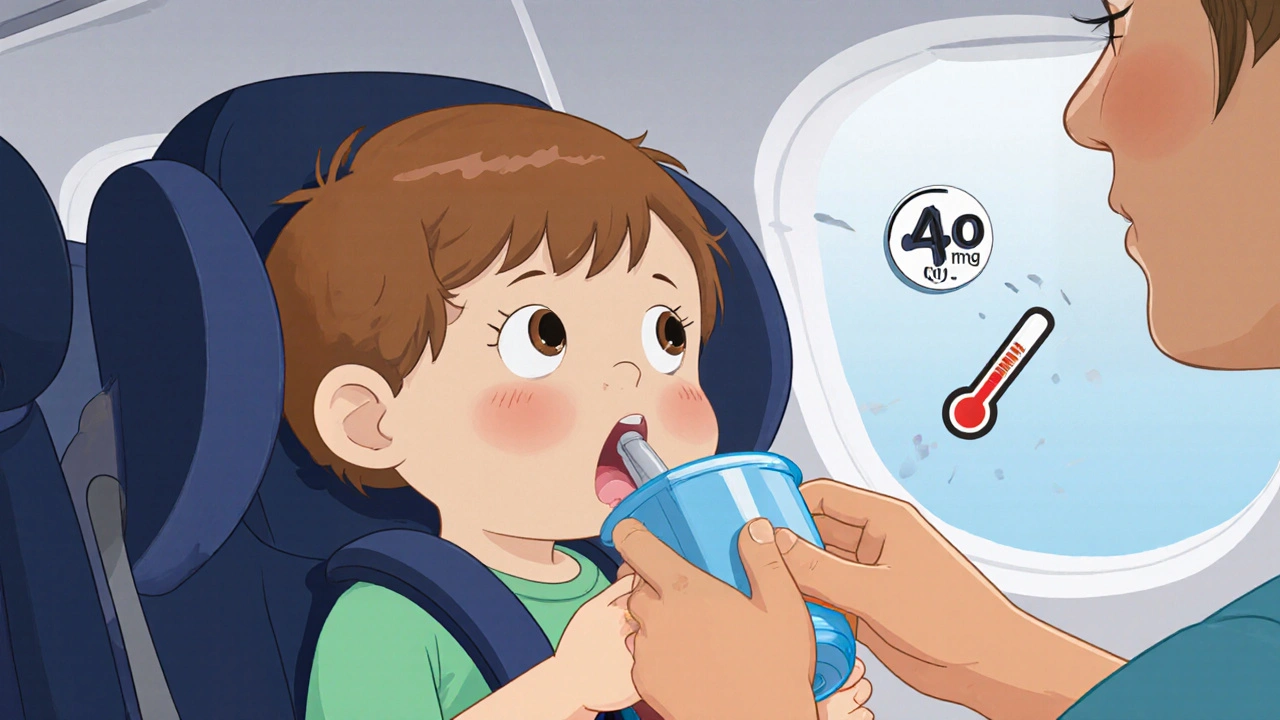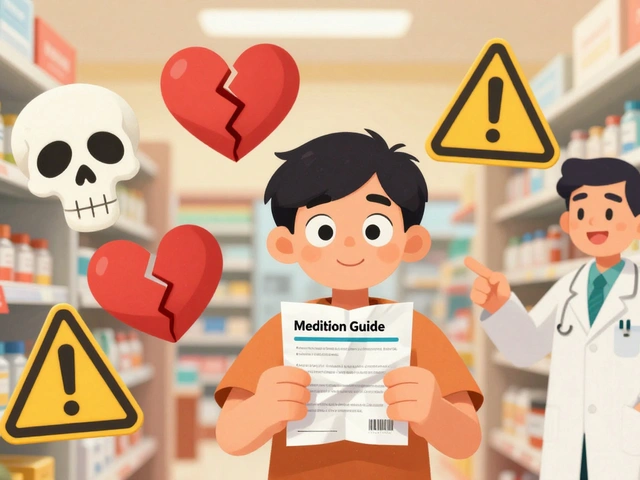Getting on a plane with a stuffy nose or ear congestion isn’t just uncomfortable-it can be painful. Many people ignore the warning signs until they’re mid-descent, ears screaming, head throbbing, and hearing muffled. This isn’t just "normal" flying discomfort. It’s airplane ear, or barotrauma, and it happens when the pressure inside your middle ear can’t keep up with the rapid changes outside during takeoff and landing. The Eustachian tube, a tiny canal connecting your ear to your throat, is supposed to open and balance that pressure. But when it’s swollen from a cold, allergies, or just being a kid, it gets stuck. And that’s when things go wrong.
Why Your Ears Hurt During Flights
Your ears aren’t broken. They’re just caught in a pressure race. As the plane climbs, cabin pressure drops-about 0.5 psi for every 1,000 feet. That means the air inside your middle ear is now higher than the air outside. Your eardrum bulges outward. During descent, the opposite happens: cabin pressure rises, pulling your eardrum inward. If your Eustachian tube doesn’t open to let air flow in or out, you’re stuck with that pressure difference. At its worst, it can reach 40 mmHg-enough to cause sharp pain, temporary hearing loss, or even a ruptured eardrum in rare cases.Children are more vulnerable. Their Eustachian tubes are shorter (17-18mm vs. 35-38mm in adults), more horizontal, and less developed. That’s why 22% of kids experience significant ear pain during flights-up to 34% if they have allergies. Adults aren’t immune. About 10% feel it, but that number jumps if you’re congested or flying with a recent cold.
What Actually Works: Proven Equalization Techniques
There’s no magic fix, but some methods work far better than others-and some can actually hurt you if done wrong.- Swallowing and yawning: The safest, most natural method. It works 65% of the time. Try chewing gum, sucking on hard candy, or sipping water. It’s free, risk-free, and works best when started early-before you feel pain.
- The Toynbee maneuver: Pinch your nose shut and swallow. This uses throat muscles to pull the Eustachian tube open. It’s safer than blowing, but only works about 68% of the time, especially for kids under seven.
- The Valsalva maneuver: Pinch your nose and gently blow. Sounds simple, but it’s where most people mess up. Blowing too hard can rupture your eardrum or damage your inner ear. Studies show 0.3% of attempts cause injury. Do it like you’re blowing through a straw-not a firehose. Hold for 3-5 seconds. Only use this if swallowing isn’t enough.
- The Lowry technique: A combo of Valsalva and Toynbee. Pinch your nose, blow gently, and swallow at the same time. This boosts success to 89%, but most people can’t do it right on the first try. Practice at home before your flight.
- Jaw wiggle: Move your jaw side to side while swallowing. Sounds silly, but it’s backed by data. Dr. Michael Cohen at SingHealth found it improves success by 22% in children. Try it during descent-it’s easy, safe, and surprisingly effective.
For adults, combining techniques works best. Use EarPlanes (filtered earplugs) + jaw wiggles + swallowing. One Reddit thread with 147 user reports showed 91% success with this combo. Don’t wait until you’re in pain. Start at 8,000 feet during descent, and repeat every 300-500 feet. That’s about every 2-3 minutes.
Earplugs, Decongestants, and Other Tools
There’s a whole industry built around ear pressure relief. But not all of it works.Filtered earplugs like EarPlanes slow down pressure changes by 37%. They give your Eustachian tube more time to catch up-about 28 seconds instead of 15. They’re 76% effective for most people. But if you have chronic Eustachian tube dysfunction, their success drops to 42%. They cost about $5 a pair and are worth trying if you fly often.
Nasal decongestant sprays (like Afrin with oxymetazoline) shrink swollen tissues in your nose and throat within 10 minutes. They’re 85% effective when used 30-60 minutes before descent. But they’re not for everyone. Overuse can cause rebound congestion. And for adults over 40, they carry a small risk of high blood pressure or heart issues. The FDA warns against using them if you have heart disease, high blood pressure, or thyroid problems.
Oral decongestants like Sudafed (pseudoephedrine) last longer-8 to 12 hours-but can cause jitteriness, insomnia, or elevated heart rate. Don’t use them if you’re pregnant, have glaucoma, or are on certain medications.
For kids: Never give them decongestants under age 6. Instead, feed them a bottle or sippy cup during descent. Swallowing while feeding is stronger than just sipping. Studies show it’s 43% more effective at equalizing pressure. Keep them awake during descent. Sleeping through landing is the #1 reason kids end up in the ER with ear pain.

What Not to Do
Most people make the same mistakes-and pay for it.- Waiting until it hurts: 68% of sufferers wait too long. By then, the pressure difference is too big. Start equalizing as soon as the plane begins descending.
- Blowing too hard: 41% of inner ear injuries from Valsalva happen because people blow like they’re trying to inflate a tire. Gentle is key.
- Sleeping during descent: 73% of pediatric ear pain cases occur because the child was asleep. Keep them awake and active.
- Using decongestants too early: Taking them 2 hours before flight? Too soon. They wear off before descent. Take them 30-60 minutes before landing.
When to See a Doctor
If you have frequent ear pain during flights, it’s not just bad luck. You might have chronic Eustachian tube dysfunction. Symptoms include: persistent muffled hearing, ear fullness lasting days after flying, or pain that doesn’t go away.New treatments are emerging. The FDA approved the Otovent device in 2022-a nasal balloon you inflate with your nose. It opens the Eustachian tube directly. Clinical trials show 88% effectiveness. For severe cases, a new procedure called balloon dilation is available. A tiny balloon is inserted into the Eustachian tube and inflated to widen it. Success rates are 76% long-term, but it costs $3,800-$5,200 out-of-pocket in the U.S.
There’s also promising research on nasal steroid sprays like fluticasone. A 2023 University of Pennsylvania study found they reduce inflammation in the Eustachian tube by 61% and improve equalization success by 33%. Use them daily for a week before flying-not just the day before.

What Airlines Are Doing
Airlines aren’t ignoring this. Boeing’s 787 Dreamliner maintains cabin altitude at 6,000 feet instead of the old standard of 8,000 feet. That reduces pressure changes by 25%. Delta Airlines now uses a gentler 3-degree descent angle instead of 3.5 degrees, slowing pressure changes by 14%. The FAA now requires all major U.S. carriers to train crew on how to help passengers with ear pressure. They’re not just handing out gum anymore-they’re learning how to guide people through techniques.Future tech is coming. Bose is testing smart earplugs with pressure sensors that light up when you equalize correctly. The FAA is also considering a 2025 rule that would require all new planes to keep cabin altitude below 6,500 feet during takeoff and landing. That could make airplane ear a thing of the past-for most people.
Quick Checklist Before Your Next Flight
- Check for congestion: If you’re stuffed up, skip decongestants if under 6 or over 40 with heart issues.
- Start swallowing or chewing gum 30 minutes before descent.
- Use filtered earplugs if you fly often or have mild issues.
- For kids: Keep them awake. Feed or drink during descent. Use jaw wiggles.
- Never blow hard during Valsalva. Gentle pressure only.
- If pain lasts more than a day after landing, see an ENT.
Flying doesn’t have to hurt. You don’t need to suffer through every descent. With the right tools and timing, you can make your ears happy-even at 35,000 feet.











Shirou Spade
It's wild how something so universal-like flying-can feel like a personal betrayal when your ears start screaming. I used to think it was just bad luck until I learned about the Eustachian tube's role. Turns out, it’s not about being weak or sensitive, it’s anatomy. And yet, we treat it like a flaw to be endured. Maybe we need to reframe this: it’s not that your body’s failing, it’s that our systems haven’t caught up to the speed of modern travel. We rush through pressure changes like they’re just noise, but our bodies are still wired for the slow, quiet world we evolved in.
That’s why the jaw wiggle works-it’s not magic, it’s biomechanics. Moving the jaw mimics the natural chewing motions our ancestors did while eating tough foods, which kept those tubes open. We’ve lost that rhythm. Now we sit there, glued to screens, swallowing air like it’s a chore. Maybe the real solution isn’t just techniques-it’s awareness. We need to relearn how to listen to our bodies, not just tolerate them.
And honestly? I think airlines should be required to play a 30-second audio cue during descent: ‘Swallow now. Breathe. Wiggle your jaw.’ Not ads. Not in-flight movies. Just a quiet reminder that your ears are still alive in there.
fiona collins
Start swallowing before descent. Always. Even if you feel fine. Even if you’re not congested. It’s that simple.
EarPlanes? Worth it. I’ve flown 28 times this year. No more pain.
Don’t sleep through landing. Ever.
And please, no Valsalva unless you’ve practiced. It’s not a power move.
Rachel Villegas
I’ve had chronic Eustachian tube dysfunction since I was a kid, and I’ve tried everything. The Otovent device changed my life. It’s not glamorous, but it’s effective. I carry it in my carry-on now. I also use fluticasone daily for three days before any flight-it’s not a quick fix, but it’s the only thing that consistently reduces the inflammation.
Also, if you’re on a long-haul, try chewing gum during takeoff too. The pressure changes aren’t just at landing. They’re constant. And yes, I know it’s annoying to hear people crunching, but trust me-it’s better than the sound of someone crying in the seat behind you.
giselle kate
Why are we still talking about this like it’s some new discovery? The U.S. Air Force figured this out in the 1950s. Pilots were popping eardrums left and right. They developed the Valsalva, the Toynbee, the Lowry-all of it. But now? We’ve got a generation of people who think chewing gum is a breakthrough. Meanwhile, other countries train their kids to equalize before they even start school. We’re falling behind because we’ve turned medical common sense into a viral Reddit post.
And don’t get me started on EarPlanes. They’re fine for amateurs. Real professionals? They use pressure-regulating nasal inserts designed by the FAA. You want to fly without pain? Stop treating this like a lifestyle hack. It’s physiology. And if you can’t handle basic biology, maybe you shouldn’t be flying at all.
Emily Craig
So let me get this straight-you’re telling me I have to WIGGLE MY JAW on a plane like I’m doing yoga in a spa while my toddler screams for juice and the guy next to me is snoring like a chainsaw?
And you want me to believe this is the future of aviation? Boeing’s lowering cabin altitude so my ears don’t explode… while the WiFi still cuts out every 3 minutes?
I’ll take my 8,000-foot pressure torture and my $300 ticket thank you very much. At least I know I’m not paying for a luxury experience. I’m paying for survival. And if that means chewing gum like a beaver while my 4-year-old chugs apple juice and I pretend I’m not crying inside? Fine. I’m a grown adult. I can handle it.
Also-yes, I used the Valsalva once. I thought I was a superhero. Turned out I was just a dumbass with a ruptured eardrum. Lesson learned. Gentle. Always gentle. Even when the flight attendant is yelling ‘We’re descending!’ like it’s a game show.
Karen Willie
For anyone with kids: don’t wait until the descent to start feeding. Start when the seatbelt sign goes off. Even if they’re not hungry. Sipping or sucking is the best natural equalizer. I used to panic every time we flew with my daughter until I learned this. Now she’s 7, and she chews gum, swallows, and wiggles her jaw like a pro. She even reminds me now. ‘Mom, you forgot to swallow!’
And yes, I use EarPlanes. I’m not rich, but I spend $10 every few months on them. It’s cheaper than the $200 ER visit I had after ignoring my own advice. Small habits, big relief.
You don’t need to be perfect. You just need to start before it hurts.
Leisha Haynes
Let’s be real-the only reason this is even a topic is because people wait until the last second to do anything
Same with everything else in life right? Wait until your back is killing you to stretch. Wait until you’re broke to budget. Wait until your ears are screaming to swallow
And then you wonder why you’re in pain
Also-no one is telling you to do all seven techniques at once. Pick one. Do it early. Do it consistently. That’s it
Stop overcomplicating it. Your body isn’t broken. You’re just lazy
Also-yes I used Valsalva once and it felt like my brain popped
Don’t be that person